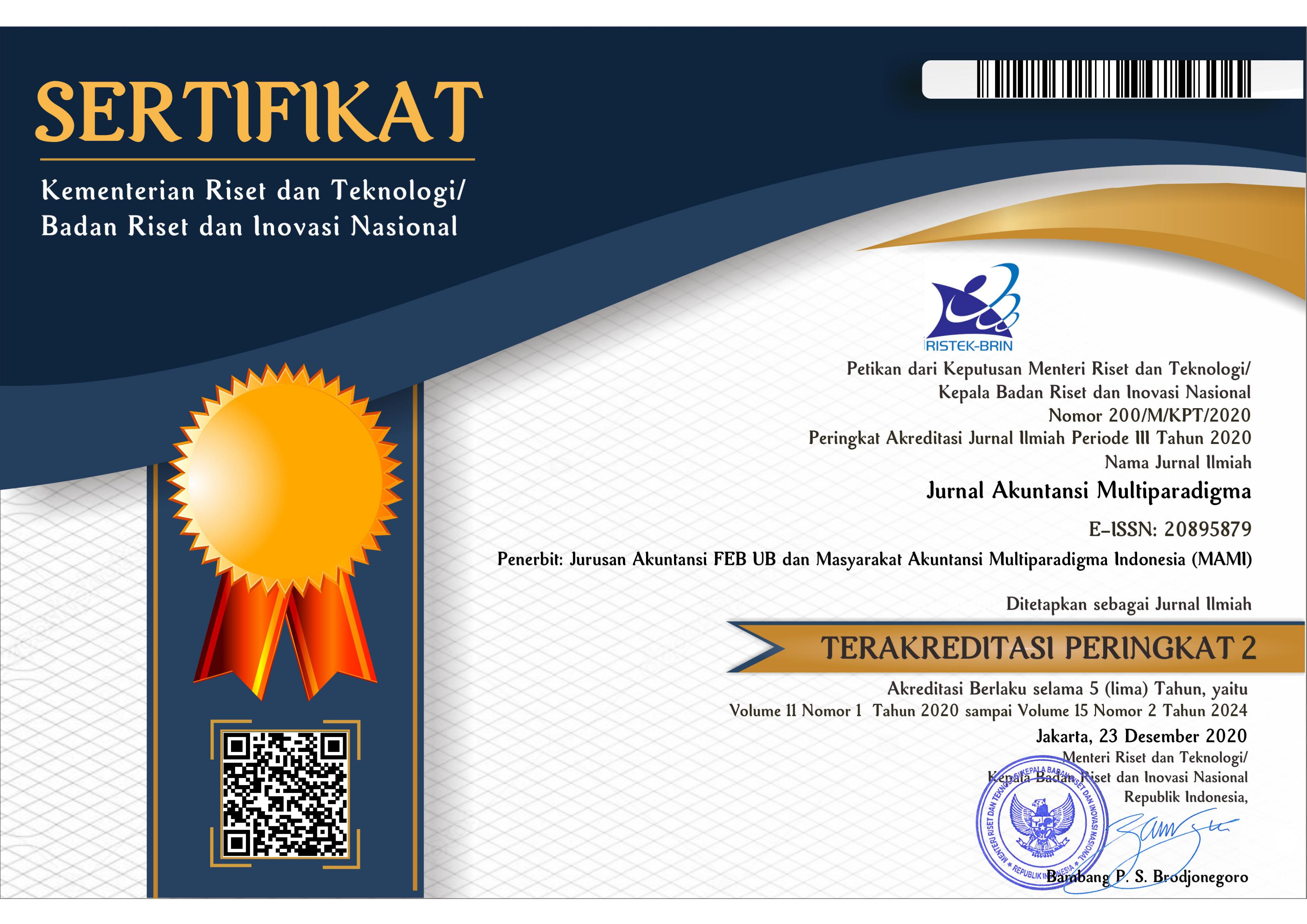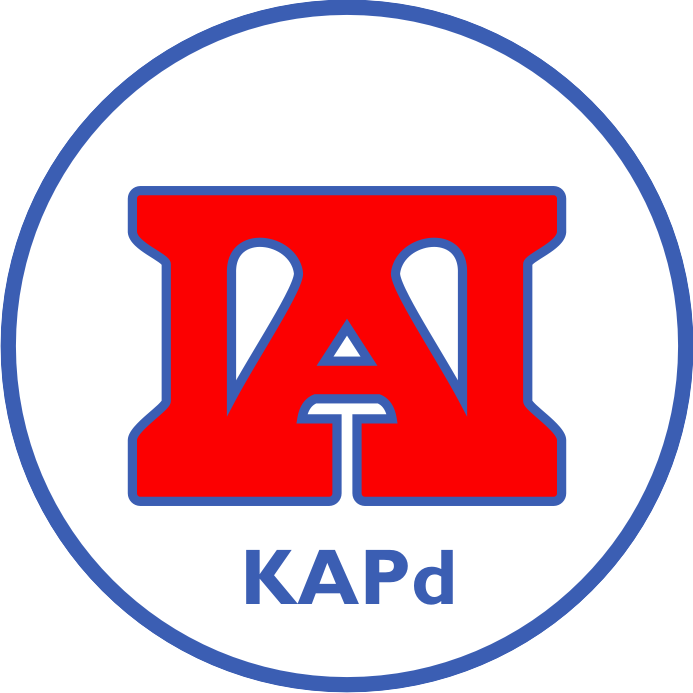HARUSKAH VALUE CREATION HANYA TERDAPAT PADA INTEGRATED REPORTING?
Abstract
Abstrak: Haruskah Value Creation Hanya Terdapat pada Integrated Reporting? Penelitian ini bertujuan untuk mengkaji apakah Integrated Reporting (IR) layak dijadikan media tunggal untuk mengungkapkan value creation, atau ada alternatif lain. Penelitian ini menggunakan metode analisis wacana pada pelaporan berkelanjutan beberapa perusahaan di Indonesia. Hasil penelitian menunjukkan bahwa value creation yang merupakan esensi dari IR tidak harus diungkapkan dalam IR. Hal ini disebabkan karena pengungkapan multiple capitals, value creation, dan informasi keberlanjutan tidak hanya diungkapkan dalam IR. Informasi ini juga terdapat dalam annual report dan laporan berkelanjutan pada perusahaan yang tidak menyajikan IR.
Abstract: Must Value Creation be Only Included in Integrated Reporting? This research aimed to review whether Integrated Reporting (IR) can became the only medium for disclosing value creation, or there is another alternative. This research used discourse analysis at several companies reporting in Indonesia. The research findings showed that the value creation, that essential in IR, didn’t have to be disclosed in IR. This was due to disclosures of multiple capitals, value creation and sustainability information were not only disclosed in IR. It could be seen in the annual report and sustainability report of the company which doesn’t make IR.
Keywords
Full Text:
PDFReferences
Adams, C. A. (2015). The International Integrated Reporting Council: A Call to Action. Critical Perspectives on Accounting, 27, 23–28. https://doi.org/10.1016/j.cpa.2014.07.001
Adams, C. A. (2017). Conceptualising the Contemporary Corporate Value Creation Process. Accounting, Auditing & Accountability Journal, 30(4), 906–931. https://doi.org/10.1108/AAAJ-04-2016-2529
Baker, P., & Ellece, S. (2011). Key Terms in Discourse Analysis. London: Continuum.
Barter, N. (2015). Natural Capital: Dollars and Cents/Dollars and Sense. Sustainability Accounting, Management and Policy Journal, 6(3), 366–373. https://doi.org/10.1108/SAMPJ-02-2014-0011
Beck, C., Dumay, J., & Frost, G. (2015). In Pursuit of a “Single Source of Truth”: from Threatened Legitimacy to Integrated Reporting. Journal of Business Ethics, 141(1), 191–205. https://doi.org/10.1007/s10551-014-2423-1
Brennan, N. M., Guillamon-Saorin, E., & Pierce, A. (2009). Methodological Insights: Impression management: Developing and Illustrating A Scheme of Analysis for Narrative Disclosures - A Methodological Note. Accounting, Auditing & Accountability Journal, 22(5), 789–832. https://doi.org/doi.org/10.1108/09513570910966379
Coulson, A. B., Adams, C. A., Nugent, M. N., & Haynes, K. (2015). Exploring Metaphors of Capitals and The Framing of Multiple Capitals. Sustainability Accounting, Management and Policy Journal, 6(3), 290–314. https://doi.org/10.1108/SAMPJ-05-2015-0032
Creswell, J. W. (2014). Research Design: Qualitative, Quantitative, and Mixed Methods Approaches. California: Sage Publications, Inc.
Deegan, C. (2007). Financial Accounting Theory. Singapore: Mc Graw Hill.
Diouf, D., & Boiral, O. (2017). The Quality of Sustainability Reports and Impression management. Accounting, Auditing & Accountability Journal, 30(3), 643–667. https://doi.org/10.1108/AAAJ-04-2015-2044
Dosinta, N. F., Brata, H., & Heniwati, E. (2017). Implikasi Legitimacy Theory Dalam CSR Bank Kalbar Untuk Peningkatan Kualitas SDM di Kalimantan Barat. In Seminar Nasional Penerapan Ilmu Pengetahuan dan Teknologi (PIPT) (pp. 5–16). Pontianak.
Eisenhardt, K. M. (1989). Building Theories from Case Study Research. The Academy of Management Review, 14(4), 532–550. https://doi.org/10.2307/258557
Eriksson, P., & Kovalainen, A. (2016). Qualitative Methods in Business Research. London: Sage Publications.
Flower, J. (2015). The International Integrated Reporting Council : A Story of Failure. Critical Perspectives on Accounting, 27, 1–17. https://doi.org/10.1016/j.cpa.2014.07.002
Haji, A. A., & Anifowose, M. (2016). The Trend of Integrated Reporting Practice in South Africa: Ceremonial or Substantive? Sustainability Accounting, Management and Policy Journal, 7(2), 190–224. https://doi.org/10.1108/SAMPJ-11-2015-0106
Haji, A. A., & Hossain, D. M. (2016). Exploring The Implications of Integrated Reporting on Organisational Reporting Practice. Qualitative Research in Accounting & Management, 13(4), 415–444. https://doi.org/10.1108/QRAM-07-2015-0065
Higgins, C., Stubbs, W., & Love, T. (2014). Walking The Talk(s): Organisational Narratives of Integrated Reporting. Accounting, Auditing & Accountability Journal, 27(7), 1090–1119. https://doi.org/10.1108/AAAJ-04-2013-1303
Hsiao, P. C. K., & Kelly, M. (2018). Investment Considerations and Impressions of Integrated Reporting. Sustainability Accounting, Management and Policy Journal, 9(1), 2–28. https://doi.org/10.1108/SAMPJ-10-2016-0072
IIRC. (2013). The International Integrated Reporting Framework. Tersedia pada www.theirc.org (Diakses: 17 Juni 2017).
Indrawati, N., Darlis, E., & Azhar, A. L. (2017). The Accuracy of Earning Forecast Analysis, Information Asymmetry and Integrated Reporting – Case of Indonesia. Jurnal Dinamika Akuntansi dan Bisnis (JDAB), 4(1), 19–32. https://doi.org/10.24815/jdab.v4i1.5843
Kamayanti, A. (2016). Metodologi Penelitian Kualitatif Akuntansi. Jakarta: Yayasan Rumah Peneleh.
Khalifa, R., & Mahama, H. (2017). Discourse Analysis in Accounting Research. In Z. Hoque, L. D. Parker, M. A. Covaleski, & K. Haynes (Eds.), The Routledge Companion to Qualitative Accounting Research Methods (pp. 250–262). New York: Routledge.
Krippendorff. (2013). Content Analysis: An introduction to its methodology. California: Thousand Oaks.
Lindawati, A. S. L., & Puspita, M. E. (2015). Corporate Social Responsibility: Implikasi Stakeholder dan Legitimacy Gap dalam Peningkatan Kinerja Perusahaan. Jurnal Akuntansi Multiparadigma, 6(1), 157–174. https://doi.org/10.18202/jamal.2015.04.6013
Lock, I., & Seele, P. (2016). The Credibility of CSR (Corporate Social Responsibility) Reports in Europe: Evidence from a Quantitative Content Analysis in 11 Countries. Journal of Cleaner Production, 122, 186-200. https://doi.org/10.1016/j.jclepro.2016.02.060
Maniora, J. (2017). Is Integrated Reporting Really The Superior Mechanism for The Integration of Ethics into The Core Business Model? An Empirical Analysis. Journal of Business Ethics, 140(4), 755–786. https://doi.org/10.1007/s10551-015-2874-z
McElroy, M. W., & Thomas, M. P. (2015). The Multicapital Scorecard. Sustainability Accounting, Management and Policy Journal, 6(3), 425–438. https://doi.org/10.1108/SAMPJ-04-2015-0025
Melloni, G., Stacchezzini, R., & Lai, A. (2016). The Tone of Business Model Disclosure: An Impression Management Analysis of The Integrated Reports. Journal of Management and Governance, 20(2), 295–320. https://doi.org/10.1007/s10997-015-9319-z
Modell, S. (2017). Critical Realist Accounting Research: In Search of Its Emancipatory Potential. Critical Perspectives on Accounting, 42, 20-35. https://doi.org/10.1016/j.cpa.2016.03.001
Mulawarman, A. D. (2010). Integrasi Paradigma Akuntansi: Refleksi atas Pendekatan Sosiologi dalam Ilmu Akuntansi. Jurnal Akuntansi Multiparadigma, 1(1), 155-171. https://doi.org/10.18202/jamal.2010.04.7086
Narsa, I., & Irwanto, A. (2015). Implementasi Tanggung Jawab Sosial PT Petrokimia Gresik pada Masyarakat Lokal: Apa Kata Mereka? Jurnal Akuntansi Multiparadigma, 5(3), 450-465. https://doi.org/10.18202/jamal.2014.12.5034
Neu, D., Warsame, H., & Pedwell, K. (1998). Managing Public Impressions: Environmental Disclosures in Annual Reports. Accounting, Organizations and Society, 23(3), 265–282. https://doi.org/10.1016/S0361-3682(97)00008-1
Pertiwi, I., & Ludigdo, U. (2013). Implementasi Corporate Social Responsibility Berlandaskan Budaya Tri Hita Karana. Jurnal Akuntansi Multiparadigma, 4(3), 430-455. https://doi.org/10.18202/jamal.2013.12.7208
Prihatiningtias, Y. (2012). Corporate Social Responsibility and Managing Ethical Culture. Jurnal Akuntansi Multiparadigma, 3(1), 155-160. https://doi.org/10.18202/jamal.2012.04.7151
PT Elnusa. (2014). Laporan Tahunan Terintegrasi. Tersedia pada: www.elnusa.co.id (Diakses: 18 Mei 2018).
PT Elnusa. (2017). Laporan Tahunan Terintegrasi. Tersedia pada: www.elnusa.co.id (Diakses: 18 Mei 2018).
PT Pertamina EP. (2014). Laporan Tahunan Terintegrasi. Tersedia pada: www.pep.pertamina.com (Diakses: 18 Mei 2018).
PT Pertamina EP. (2017). Laporan Keberlanjutan. Tersedia pada: www.pep.pertamina.com (Diakses: 21 Mei 2018).
PT Timah. (2014). Laporan Tahunan Terintegrasi. Tersedia pada: www.timah.com (Diakses: 21 Mei 2018).
PT Timah. (2016). Laporan Tahunan Terintegrasi. Tersedia pada: www.timah.com (Diakses: 21 Mei 2018).
PT Timah. (2017a). Laporan Keberlanjutan. Tersedia pada: www.timah.com (Diakses: 21 Mei 2018).
PT Timah. (2017b). Laporan Tahunan. Tersedia pada: www.timah.com (Diakses: 22 Mei 2018).
Qiu, Y., Shaukat, A., & Tharyan, R. (2016). Environmental and Social Disclosures: Link with Corporate Financial Performance. The British Accounting Review, 48(1), 102-116. https://doi.org/10.1016/j.bar.2014.10.007
Rajandran, K., & Taib, F. (2014). The Representation of CSR in Malaysian CEO Statements: A Critical Discourse Analysis. Corporate Communications: An International Journal, 19(3), 303–317. https://doi.org/10.1108/CCIJ-02-2013-0011
Setia, N., Abhayawansa, S., Joshi, M., & Huynh, A. V. (2015). Integrated Reporting in South Africa: Some Initial Evidence. Sustainability Accounting, Management and Policy Journal, 6(3), 397–424. https://doi.org/10.1108/SAMPJ-03-2014-0018
Setiawan, A. (2016). Integrated Reporting: Are Indonesian Companies Ready to Do It? Asian Journal of Acconting Research, 1(2), 62–70. https://doi.org/10.1108/AJAR-2016-01-02-B004
Smith, M. (2015). Research Methods in Accounting. London: Sage Publications.
Somantri, G. R. (2005). Memahami Metode Kualitatif. Makara: Sosial Humaniora, 9(2), 57–65. https://doi.org/10.7454/mssh.v9i2.122
Stubbs, W., & Higgins, C. (2014). Integrated Reporting and Internal Mechanisms of Change. Accounting, Auditing & Accountability Journal, 27(7), 1068–1089. https://doi.org/10.1108/AAAJ-03-2013-1279
Thomson, I. (2015). “But does Sustainability need Capitalism or An Integrated report” A Commentary on “The International Integrated Reporting Council: A story of Failure” by Flower, J. Critical Perspectives on Accounting, 27, 18–22. https://doi.org/10.1016/j.cpa.2014.07.003
Toit, E. D. (2017). The Readability of Integrated Reports. Meditari Accountancy Research, 25(4), 629–653. https://doi.org/10.1108/MEDAR-07-2017-0165
Triyuwono, I. (2013). [Makrifat] Metode Penelitian Kualitatif [dan Kuantitatif] untuk Pengembangan Disiplin Akuntansi. In Simposium Nasional Akuntansi ke-16 (pp. 1–15). Manado.
Villiers, C. D., Rinaldi, L., & Unerman, J. (2014). Integrated Reporting: Insights, Gaps, and an Agenda for Future Research. Accounting, Auditing & Accountability Journal (Vol. 27). https://doi.org/10.1108/AAAJ-06-2014-1736
Vourvachis, P., Woodward, T., Woodward, D. G., & Patten, D. M. (2016). CSR Disclosure in Response to Major Airline Accidents: A Legitimacy-based Exploration. Sustainability Accounting, Management and Policy Journal, 7(1), 26–43. https://doi.org/10.1108/SAMPJ-12-2014-0080
Werasturi, D. (2017). Konsep Corporate Social Responsibility berbasis Catur Purusa Artha. Jurnal Akuntansi Multiparadigma, 8(2), 319-335. https://doi.org/10.18202/jamal.2017.08.7057
Wulf, I., Niemöller, J., & Rentzsch, N. (2014). Development Toward Integrated Reporting, and its Impact on Corporate Governance: A Two-Dimensional Approach to Accounting with Reference to The German Two-tier System. Journal of Management Control, 25(2), 135–164. https://doi.org/10.1007/s00187-014-0200-z
DOI: http://dx.doi.org/10.18202/jamal.2018.04.9015
Refbacks
- There are currently no refbacks.
Copyright (c) 2018 Nina Febriana Dosinta, Handi Brata, Elok Heniwati

This work is licensed under a Creative Commons Attribution-NonCommercial 4.0 International License.

















